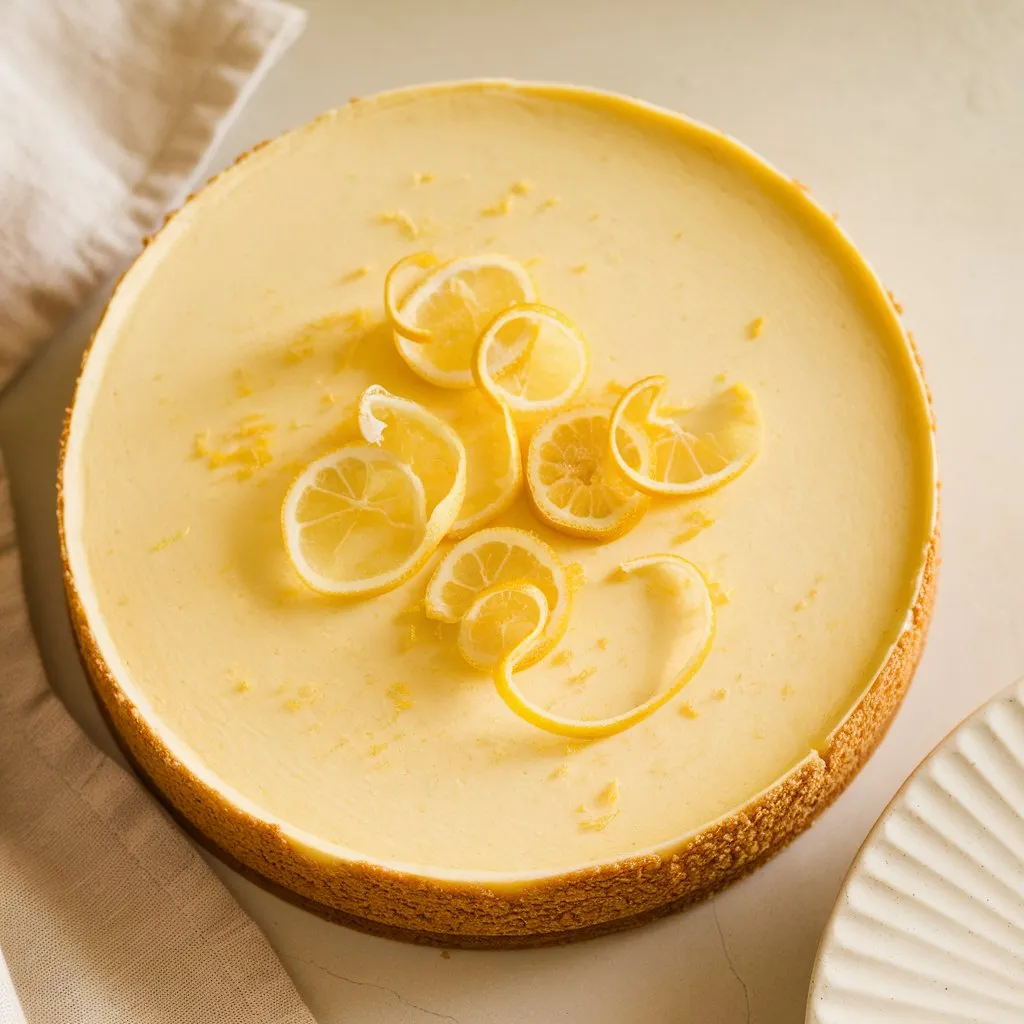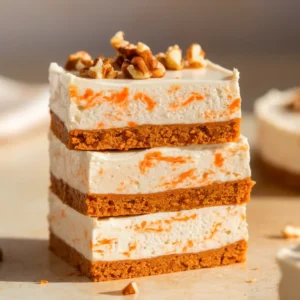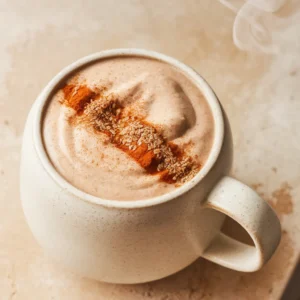Making a stellar gluten free cheesecake shouldn’t feel like performing kitchen magic, yet most recipes leave you with either a crumbly mess or something that tastes vaguely like disappointment. After testing twelve different crust combinations and countless filling ratios, this version finally delivers what every gluten-free baker dreams of: a dessert so good that gluten-eating guests forget to ask what makes it special.
The game-changer here isn’t just swapping wheat flour for alternatives – it’s understanding how different ingredients behave when you remove gluten entirely. Traditional cheesecake relies on graham crackers for structure, but this version uses toasted pecans and a touch of coconut flour to create something even better: a crust with actual flavor that won’t turn soggy after an hour on the counter.
This recipe emerged from pure necessity when my sister announced her celiac diagnosis two weeks before Thanksgiving. Rather than serve a sad substitute dessert, this gluten free cheesecake became the star of our holiday table – and now gets requested more often than the original version ever did.
Table of Contents
What’s So Good?
❀ Actually tastes better than regular cheesecake – the pecan crust adds richness that graham crackers can’t match
❀ Slices cleanly without crumbling – holds together perfectly for serving and photos
❀ No weird aftertaste – zero grittiness or chemical flavors from alternative flours
❀ Surprisingly simple technique – fewer steps than most traditional recipes
❀ Serves a crowd – one 10-inch cheesecake feeds 14 people generously
❀ Three-day shelf life – flavors actually improve as it sits in the refrigerator
What You’ll Need
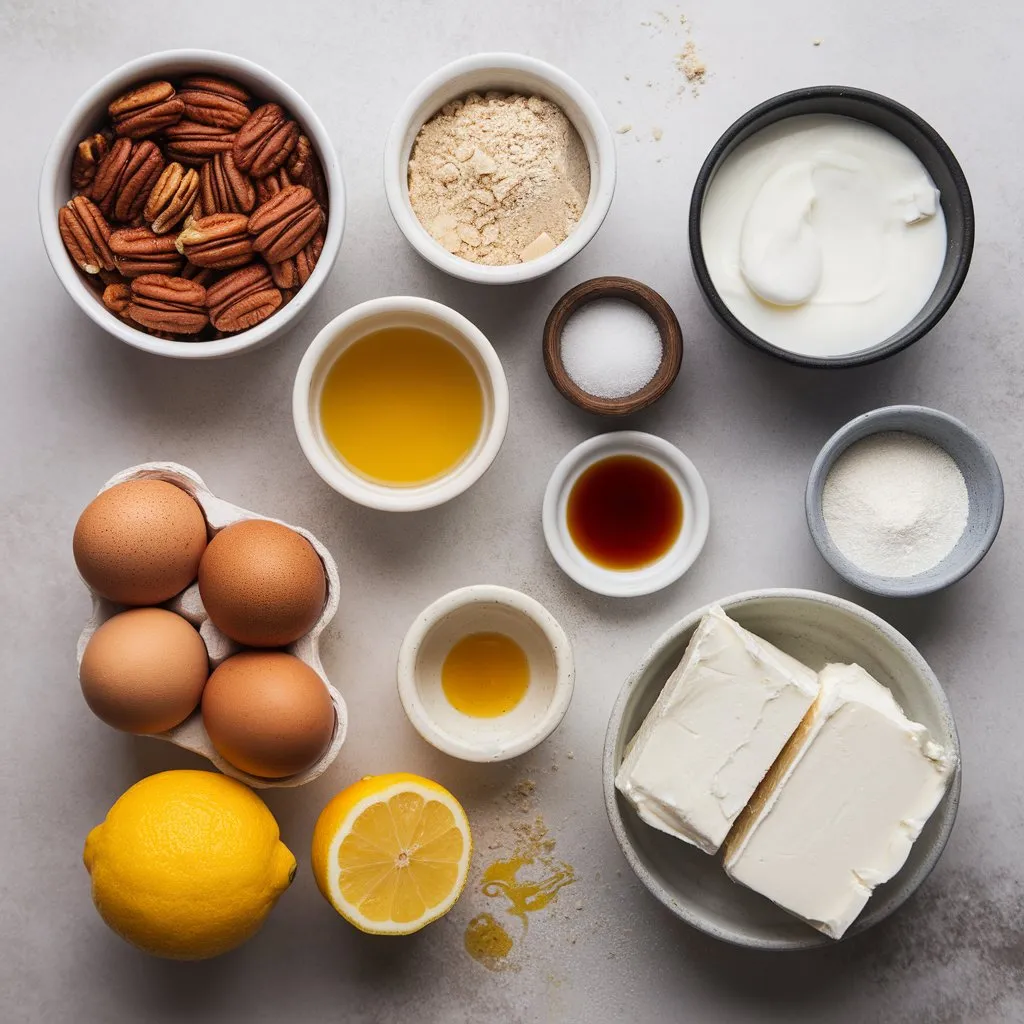
❧ For the Pecan Crust:
• 2½ cups raw pecan halves – toasting these yourself makes a huge difference in flavor depth
• ¼ cup coconut flour – provides binding without heaviness (regular flour works too if not avoiding gluten entirely)
• 3 tablespoons maple syrup – adds subtle sweetness and helps everything stick together
• 2 tablespoons coconut oil, melted – creates the right texture without butter’s water content
• ½ teaspoon sea salt – essential for balancing the nuts’ richness
❧ For the Cream Cheese Base:
• 32 oz full-fat cream cheese – must be completely soft or the texture suffers dramatically
• 1 cup organic cane sugar – regular sugar works, but cane sugar dissolves more smoothly
• 4 large farm eggs – room temperature prevents lumpy batter
• ¾ cup full-fat Greek yogurt – tanginess that makes the difference between good and extraordinary
• 2 tablespoons pure vanilla extract – cheap vanilla ruins everything, splurge here
• 1 tablespoon fresh lemon juice – brightens the entire flavor profile
• 3 tablespoons tapioca starch – prevents weeping and creates silky texture
Shopping notes: Find coconut flour in the baking aisle near gluten-free products. Tapioca starch (also called tapioca flour) is usually with Asian ingredients. Bob’s Red Mill makes both if your store carries that brand.
Let’s Bake
➲ Toast the pecans properly.
Preheat oven to 325°F. Spread pecans on a rimmed baking sheet and toast for 8–12 minutes, stirring once halfway through. They should smell fragrant and look slightly darker. Cool completely before proceeding – hot nuts will melt the coconut oil too quickly.
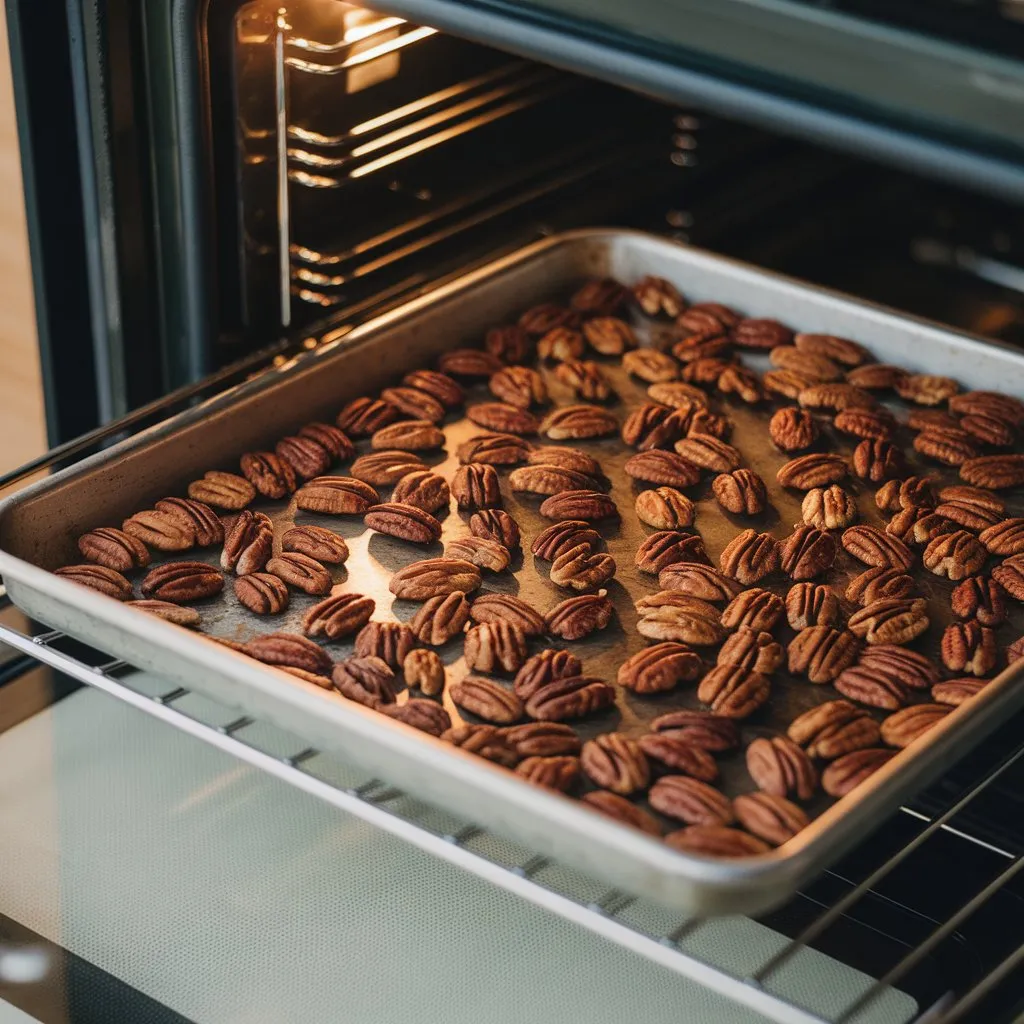
➲ Create the crust mixture.
Pulse cooled pecans in a food processor until they form coarse crumbs with some larger pieces still visible. Add coconut flour and salt, pulsing twice to combine. Drizzle in maple syrup and melted coconut oil while pulsing until the mixture clumps together when squeezed.
➲ Press and pre-bake the base.
Grease a 10-inch springform pan thoroughly. Press the pecan mixture firmly into the bottom, using a flat-bottomed measuring cup to create an even layer. Bake for 15 minutes until the edges look set and lightly golden. Remove and cool while preparing the filling.

➲ Perfect the cream cheese base.
Beat softened cream cheese with an electric mixer for 3–4 minutes until completely smooth – no shortcuts here. Gradually add sugar, beating until fluffy and light colored. This step determines your final texture, so don’t rush it.
➲ Add eggs strategically.
Beat in eggs one at a time on low speed, waiting until each is fully incorporated before adding the next. Overmixing after adding eggs creates a tough texture, so gentle handling is crucial here.
➲ Finish the filling.
Fold in Greek yogurt, vanilla, lemon juice, and tapioca starch with a rubber spatula until just combined. The batter should look smooth and pourable but not overworked.
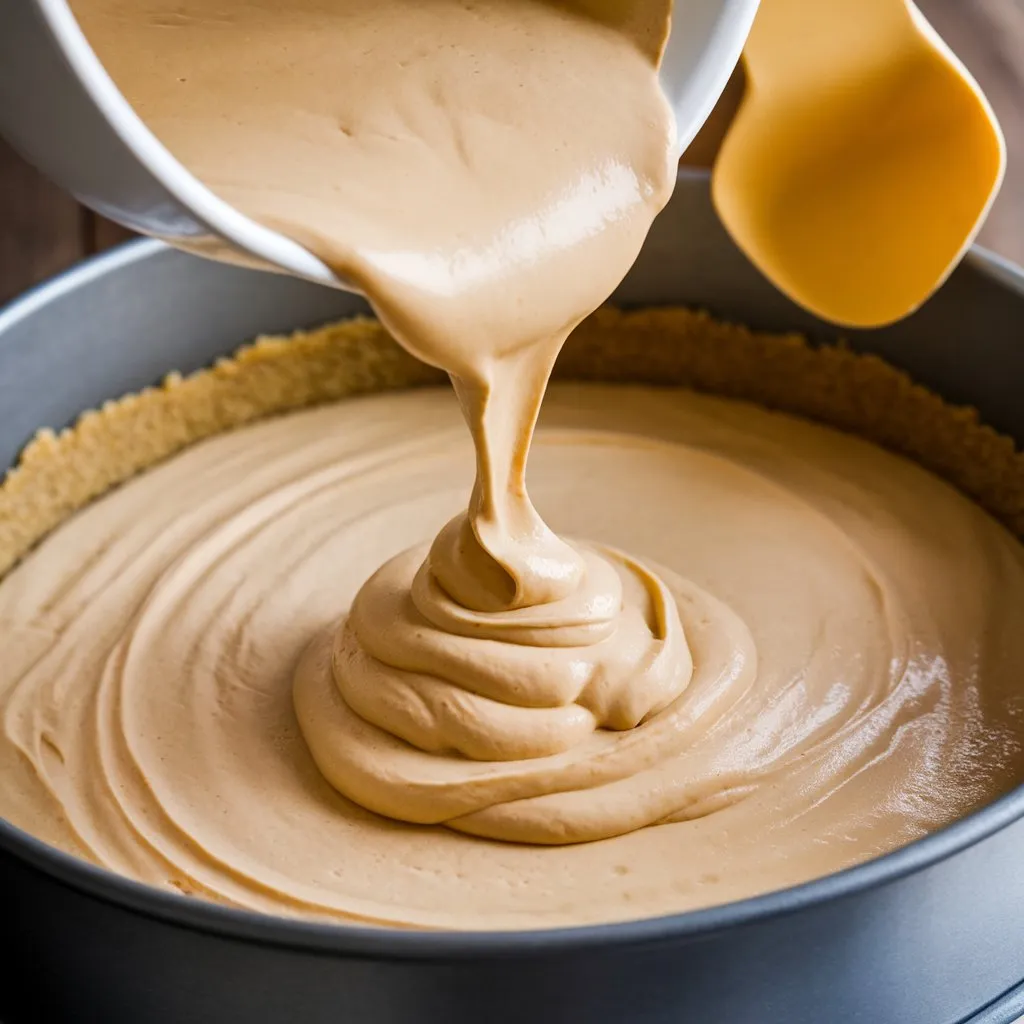
➲ Assemble and bake slowly.
Pour filling over the pre-baked crust, smoothing the top gently. Bake at 325°F for 45–50 minutes, until the center still jiggles slightly when the pan is gently shaken. The edges should look set and lightly puffed.
➲ Cool gradually to prevent cracking.
Turn off oven and crack the door open. 8.Let the cheesecake cool in the oven for 1 hour, then move to room temperature for another hour before refrigerating.
➲ Chill thoroughly before serving.
Refrigerate for at least 6 hours, though overnight is better. Run a thin knife around the edges before removing the springform sides to ensure clean release.
Smart Tips
❀ Ingredient temperature matters more than timing: everything should feel barely warm to the touch before mixing. Cold ingredients create lumps that never fully disappear, while too-warm ingredients can cause curdling.
❀ Test your oven’s accuracy: most run 25°F hotter than displayed. An oven thermometer prevents overbaking, which creates that dreaded rubbery texture that ruins gluten-free desserts.
❀ The toothpick test doesn’t work here: unlike regular cakes, cheesecake should still jiggle in the center when done. It continues cooking as it cools and will set perfectly in the refrigerator.
❀ Slice with confidence: use a sharp chef’s knife dipped in warm water between cuts. Wipe the blade clean after each slice for professional-looking portions.
❀ Storage extends flavor development: this gluten free cheesecake tastes significantly better on day two as flavors meld and the texture becomes even creamier.
Q&A Time
❧ What happens if the crust gets soggy?
The coconut flour and pre-baking step specifically prevent this issue, but if moisture does seep in, place individual slices under the broiler for 30 seconds to re-crisp the bottom before serving.
❧ Can nuts be substituted for the pecan crust?
Absolutely – try toasted walnuts, almonds, or even macadamia nuts. Each creates a different flavor profile but the same sturdy texture. Avoid cashews as they’re too soft when ground.
❧ How do you know when it’s actually done?
The center should jiggle like thick pudding when gently shaken – not liquid, but definitely not solid. The edges will look slightly puffed and set. Overbaking creates that chalky texture that ruins the experience.
❧ Does this freeze well for later?
Yes, wrap individual slices in plastic wrap and freeze for up to 3 months. Thaw overnight in the refrigerator – the texture remains perfectly creamy. Avoid freezing whole cheesecakes as they’re harder to thaw evenly.
Nutrition Lowdown
- Calories (per slice): ~420
- Protein: 12g
- Carbohydrates: 18g
- Fat: 36g
- Crust benefits:
- Provides healthy monounsaturated fats
- Adds fiber from pecans
- Greek yogurt perks:
- Contains probiotics
- Boosts protein compared to sour cream
- Low refined starch:
- Tapioca starch adds minimal carbs
- Structure comes from whole food ingredients, not fillers
Conclusion
This gluten free cheesecake succeeds where others fail because it doesn’t try to mimic traditional versions – it improves on them. The pecan crust brings richness that graham crackers never could, while the carefully balanced filling achieves that perfect tangy-sweet balance that makes great cheesecake memorable.
Like it! try this next:
❀ Easy Chicken Taco Soup Recipe (Ready in 30 Minutes!)
❀ Easy 5-Ingredient Peach Ice Cream (No Ice Cream Maker!)
❀ Easy Baked Boneless Chicken Thighs with Crispy Skin in 5-steps
❀ Easy Oreo Ice Cream Recipe- Creamy and Loaded in 5-steps
Ready to ditch disappointing gluten-free desserts forever? Try this recipe and discover what you’ve been missing. Drop a comment below with your results – especially any creative topping combinations that worked well. Don’t forget to share photos of your beautiful slices on Instagram! #Gluten Free Cheesecake #easy Gluten Free Cheesecake
Gluten Free Cheesecake in 5 Simple Steps (Rich, Creamy & Foolproof) - HDrecipe
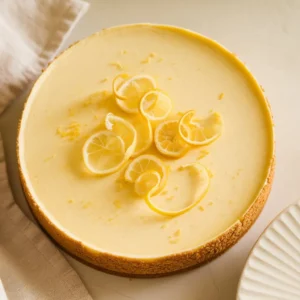
Creamy, rich gluten free cheesecake with a perfectly crisp almond flour crust that never gets soggy – even gluten-eating guests can't tell the difference.
Type: Dessert
Cuisine: American
Keywords: gluten free cheesecake, pecan crust cheesecake, gluten free dessert, celiac friendly dessert, holiday cheesecake
Recipe Yield: 14 Servings
Calories: 420 per serving
Preparation Time: PT30M
Cooking Time: PT1H5M
Total Time: PT1H35M
Recipe Ingredients:
- For the pecan crust you'll need 2½ cups raw pecan halves that should be toasted for best flavor, ¼ cup coconut flour for binding, 3 tablespoons maple syrup for sweetness, 2 tablespoons melted coconut oil, and ½ teaspoon sea salt. For the cream cheese base gather 32 oz full-fat cream cheese that must be completely soft, 1 cup organic cane sugar, 4 large farm eggs at room temperature, ¾ cup full-fat Greek yogurt for tanginess, 2 tablespoons pure vanilla extract, 1 tablespoon fresh lemon juice to brighten flavors, and 3 tablespoons tapioca starch to prevent weeping.
Recipe Instructions: Start by toasting the pecans in a 325°F oven for 8-12 minutes until fragrant and slightly darker, then cool completely. Process the cooled pecans in a food processor until they form coarse crumbs, add coconut flour and salt, then drizzle in maple syrup and melted coconut oil while pulsing until mixture clumps together. Press this mixture firmly into the bottom of a greased 10-inch springform pan and bake for 15 minutes until edges are set and lightly golden. Beat the softened cream cheese for 3-4 minutes until completely smooth, gradually add sugar until fluffy and light colored. Add eggs one at a time on low speed, waiting until each is fully incorporated before adding the next. Fold in Greek yogurt, vanilla, lemon juice, and tapioca starch with a rubber spatula until just combined. Pour filling over the pre-baked crust and bake at 325°F for 45-50 minutes until center still jiggles slightly. Cool gradually by turning off oven and cracking door open for 1 hour, then move to room temperature for another hour before refrigerating for at least 6 hours or overnight before serving.
5
